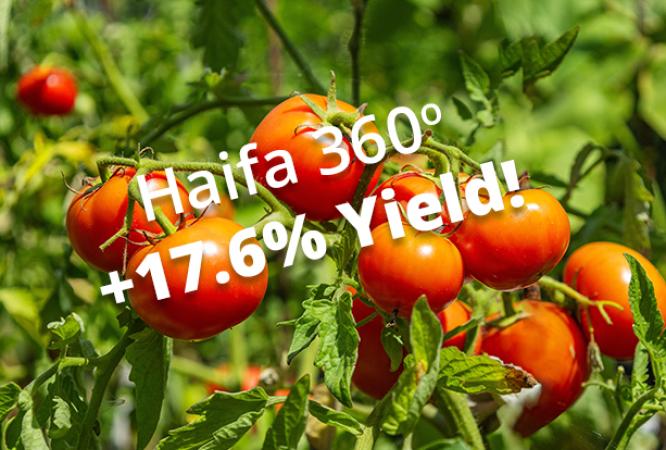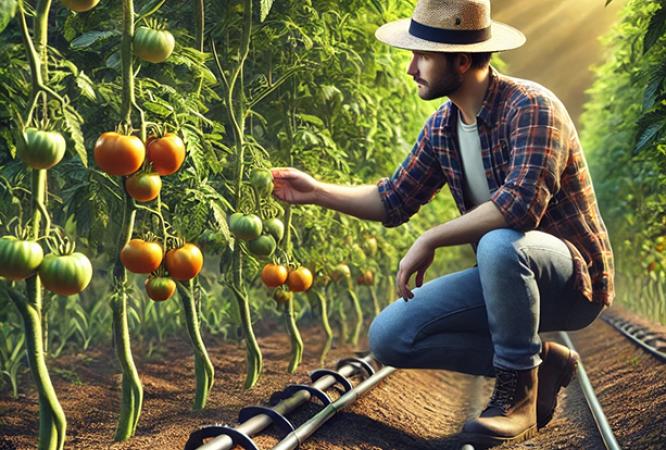Index:
1. Growing Tomato crop guide: Tomato method
Soil or soilless, protected crop (greenhouse or high plastic tunnel) or open field.

2. Tomato crop guide: Soil type
Tomatoes can be grown on soils with a wide range of textures, from light, sandy soils to heavy, clay soils. Sandy soils are preferable if early harvest is desired. Favorable pH level: 6.0-6.5. At higher or lower pH levels micronutrients become less available for plant uptake.

3. Growing Tomato crop guide: Climate
Temperature is the primary factor influencing all stages of development of the plant: vegetative growth, flowering, fruit setting and fruit ripening. Growth requires temperatures between 10°C and 30°C.
Table4: Temperature requirements during different growth stages:
Growth stage | Temperature (0C) | ||
|---|---|---|---|
Minimum | Maximum | Optimal | |
Germination | 11 | 34 | 16-29 |
Vegetative growth | 18 | 32 | 21-24 |
Fruit setting (night / day) | 10 / 18 | 20 / 30 | 13-18 / 19-24 |
Formation of lycopene | 10 | 30 | 21-24 |
Formation of carotene | 10 | 40 | 21-32 |
Light intensity is one of the major factors affecting the amounts of sugars produced in leaves during the photosynthesis, and this, in turn, affects the number of fruits that the plant can support, and the total yield.
4. GrowingTomato crop guide: Irrigation
Tomato plants are fairly resistant to moderate drought. However, proper management is essential to assure high yield and quality.
The water requirement of outdoor grown tomatoes varies between 4000 - 6000 m³/ha. In greenhouses up to 10,000 m3/ha of water are required. 70% or more of the root system are in the upper 20 cm of the soil. Therefore, a drip system equipped with a fertigation device is advisable.
On light soils or when saline water is used, it is necessary to increase water quantities by 20% - 30%. Water requirements will differ at various growth stages. The requirement increases from germination until beginning of fruit setting, reaching a peak during fruit development and then decreasing during ripening.
Mild water stress during fruit development and ripening has a positive effect on fruit quality: firmness, taste and shelf-life quality, but may result in smaller fruit. Late irrigation, close to harvesting, may impair quality and induce rotting.
Water shortage will lead to reduced growth in general and reduced uptake of calcium in particular. Calcium deficiency causes Blossom End Rot (BER) (see page 15). On the other hand, excessive irrigation will create anaerobic soil conditions and consequently cause root death, delayed flowering and fruit disorders.
Acidic (low pH) irrigation water is undesirable, as it might lead to the dissolution of toxic elements in the soil (e.g. Al3+).
5. Growing Tomato crop guide: Specific sensitivities of the tomato plant
Sensitivity to soil-borne diseases
Tomatoes are prone to soil-borne diseases caused by fungi, viruses or bacteria. Therefore it is recommended to avoid growing tomatoes on plots that used for other sensitive crops (peppers, eggplants, Irish potatoes, sweet potatoes, cotton, soybeans and others) on recent years. A regime of 3-year rotation between small grains and tomatoes is recommended.
Tomatoes are prone to soil-borne diseases caused by fungi, viruses or bacteria. Therefore it is recommended to avoid growing tomatoes on plots that used for other sensitive crops (peppers, eggplants, Irish potatoes, sweet potatoes, cotton, soybeans and others) on recent years. A regime of 3-year rotation between small grains and tomatoes is recommended.
Sensitivity to salinity
Under saline conditions, sodium cations compete with the potassium cations for the roots uptake sites, and chloride competes for the uptake of nitrate-nitrogen and will impede plant development (Fig.2) and reduce yield.
Under saline conditions, sodium cations compete with the potassium cations for the roots uptake sites, and chloride competes for the uptake of nitrate-nitrogen and will impede plant development (Fig.2) and reduce yield.
Figure 2: Inverse relationship between top dry weight and concentration of plant tissue chloride – the higher the chloride in the plant composition, the lower its dry weight.
Top dry weight (g) | 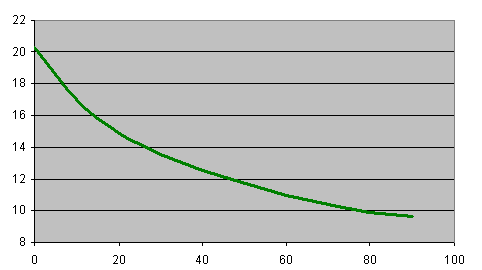 |
Cl (mg/g) |
Salinity will result in a potassium deficiency in the tomato plants, leading to a low fruit number per plant. Corrective measures under such conditions must include the following steps:
- Abundant application of potassium, as this specific cation can successfully compete with the sodium, and considerably reduce its uptake and the resulting negative effects. (Fig. 3)
- Abundant application of nitrate, as this specific anion successfully competes with chloride, and markedly reduces its uptake and adverse effects.
- Also, calcium helps suppressing the uptake of sodium. When sufficient calcium is available, the roots prefer uptake of potassium to sodium, and sodium uptake will be suppressed.
Figure 3: Multi-K® potassium nitrate reverses the adverse effects of salinity in greenhouse tomatoes
(Source: Satti et Al. 1994)
(Source: Satti et Al. 1994)
Yield (ton/ha) | 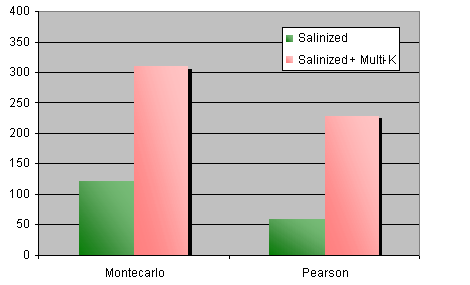 |
Salination of the nutrient solution markedly decreased dry weight of the plant, fruit size and plant height. The addition of 4 or 8 mM Multi-K® potassium nitrate to the salinized nutrient solution markedly increased EC values of the nutrient solution but reversed the said adverse effects caused by the NaCl. Several parameters were improved even over the control as a direct result of the treatment with Multi-K®, i.e., fruit size and plant height (Fig. 4).
Figure 4: The effect of salinity and Multi-K® potassium nitrate on vegetative parameters and fruit
size in ‘Pusa ruby’ greenhouse tomatoes.
size in ‘Pusa ruby’ greenhouse tomatoes.
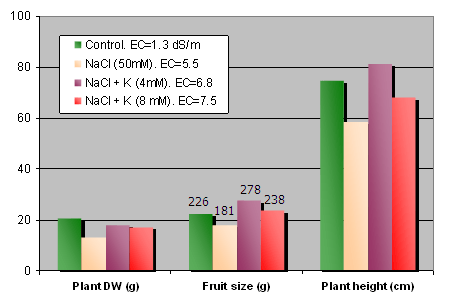
Zinc improves tolerance to salt stress
Zinc nutrition in plants seems to play a major role in the resistance to salt in tomato and other species. Adequate zinc (Zn) nutritional status improves salt stress tolerance, possibly, by affecting the structural integrity and controlling the permeability of root cell membranes. Adequate Zn nutrition reduces excessive uptake of Na by roots in saline conditions.
Zinc nutrition in plants seems to play a major role in the resistance to salt in tomato and other species. Adequate zinc (Zn) nutritional status improves salt stress tolerance, possibly, by affecting the structural integrity and controlling the permeability of root cell membranes. Adequate Zn nutrition reduces excessive uptake of Na by roots in saline conditions.
Sensitivity to calcium deficiency
Tomatoes are highly sensitive to calcium deficiency, which is manifested in the Blossom-End Rot (BER) symptom on the fruits. Salinity conditions severely enhance BER intensity. Recently, it was found that manganese (Mn) serves as antioxidant in tomato fruit, hence its application to tomatoes grown under salinity can alleviate BER symptoms in the fruits. Special care must be taken to avoid growing conditions, which enhance BER phenomenon.
Tomatoes are highly sensitive to calcium deficiency, which is manifested in the Blossom-End Rot (BER) symptom on the fruits. Salinity conditions severely enhance BER intensity. Recently, it was found that manganese (Mn) serves as antioxidant in tomato fruit, hence its application to tomatoes grown under salinity can alleviate BER symptoms in the fruits. Special care must be taken to avoid growing conditions, which enhance BER phenomenon.
Water quality: Tomatoes tolerate brackish water up to conductivity of about 2-3 mmho/cm.
Need more information about how to grow tomato? You can always return to the tomato fertilizer & tomato crop guide table of contents or the tomato plant stages




